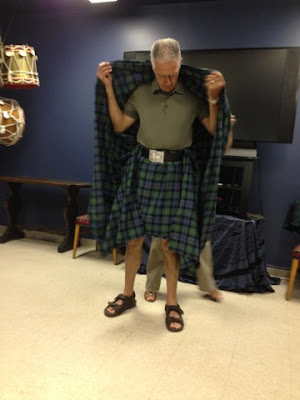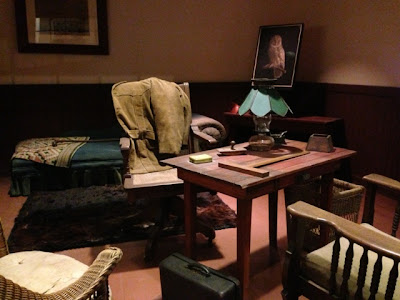July 21, 2013
We caravaned down the east side of Cape Breton. That is Garth's rig up ahead.
We stopped a few times on the way down out of the mountains and saw lots of scenic beauty along the coast in Ingonish, Wreck Cove, Breton Cove, and Indian Brook. We wound around lakes seeing eagles and seagulls and visited artists' workshops-leather and glass. Then we had a brownie, Cape Breton style, at the Clucking Hen Deli & Bakery where the sign read " no fowl moods in here".
Reverend McKenzie founded St. Ann's Gaelic College in 1938 as a school devoted to the study and preservation of the Gaelic language and Celtic arts and culture from the Scottish Highlands.
And succeed he did. Here is the piper out front playing for tips.
McKenzie was inspired by another Presbyterian minister, Reverend MacLeod who had, a century before, lived on the present College site from the 1820s to the1850s. Finding it too crowded MacLeod migrated with his flock to New Zealand.
This is the administration hall.
The only institution of its kind in North America, students come from around the world.
Instructors offer programs in Scottish traditional disciplines: Gaelic language and song, Great Highland Bagpipe, Highland and Step dance, Cape Breton fiddle, Weaving.
In the Hall of the clans several tartans are shown with the correct names. Here are two.
I attended a series of 30 minute workshops: the kilt, Gaelic song and step dance, and weaving.
A diagram in the museum shows how to prepare the great kilt for wearing.
Our teacher Ann and her apprentice prepare the kilt (the whole nine yards).
The volunteer, a Canadian from Montreal, prepares to lie on the floor. A belt is under the kilt which wraps around his waist. His wife, a professional seamstress, reached out to help.
Ann pointed out that each day the Scotsman would dress himself in this manner without the aid of any women.
In old Scotland the kilt was worn every day; the tartan represented the clan. The kilt is a versatile garment for the occasion, even used as a blanket. During battle the great kilt would be cast off so it would not be damaged; underneath was a white cloth shirt.
When the Industrial Age came, the top half of the kilt was separated from the bottom because it would get caught in the machines.
In this photo Collin step dances to Cape Breton fiddle music. Unlike Highland dancing, there is no competition in step dancing. Each person is admired for individual style. The basic steps are taught to children. Both of these people began step dancing quite young.
Unlike Irish dancing where the arms are held down stiffly, Scotish step dancing uses relaxed arms at the side.
Collin also taught us a traditional Gaelic chorus to a mill song while "working the cloth". After a piece of cloth was woven, several people would sit on two sides of a long narrow table and tighten the weave by pushing and pulling. Someone would sing the verse (sometimes improvised) and the workers would join in on the chorus.
Lunch was served cafeteria style - spaghetti and meat sauce, salad, carrot cake and lemonade.
During the lunch break we enjoyed some great music. The musicians were introduced by the CEO of the College.
Notice the piper who doesn't blow into the bag instead pressing it under his arm.
A distant relation of mine and native of Edinborough, Alexander Graham Bell's photo hangs in the Gaelic museum.
I decided to see museum devoted to his work the next day in Baddeck.
This historic site is devoted to the commemoration of Alexander Graham Bell's inventive accomplishments. It also serves as a center of study of Bell's scientific and humanitarian work.
By the time of Bell's arrival in Baddeck the success of the telephone had freed him from the need to make a living. At his castle-like home, Beinn Breagh, he continued his busy routine of experimentation and analysis.
His imagination and wide-ranging curiosity led him into scientific experiments in such areas as sound transmission, medicine, aeronautics, and marine engineering.
French & English as well as 15% sales tax.
Re-creation of Bell's study. The owl picture was painted by Mabel because Alec was a night owl.
Helen Keller was one of many guests at Beinn Bhreagh.
His wife, Mabel, had been his student when he taught the deaf in Boston. She played a vital role in his career with financial and moral support to pursue his diverse interests.
One reason they moved to this remote place was so their little girls could go about in trousers and bare feet not being bothered by social conventions.
In a video of Bell's elderly daughters reminiscing in the 1960's, one told the story of how their father loved to go bathing in the ocean even at night. He would put a life preserver around himself and lie back and light a cigar. From the house the daughters would watch that little light go round in the darkness.




















The kilt is amazing. I have new respect for it - I didn't know it had to be laid out first and that the person putting it on had to lie down. I like thinking about old traditions, how you mentioned the man and his wife knew the step dances from the time they were children. Imagine, learning a tradition like that in Vista and knowing it your whole life.
ReplyDeleteInteresting, too, thinking about Bell and his impact in the world and our ancestral ties to him and to this place. I can't stop thinking about Cloud Atlas! Thank you for sharing.